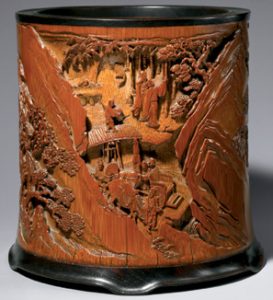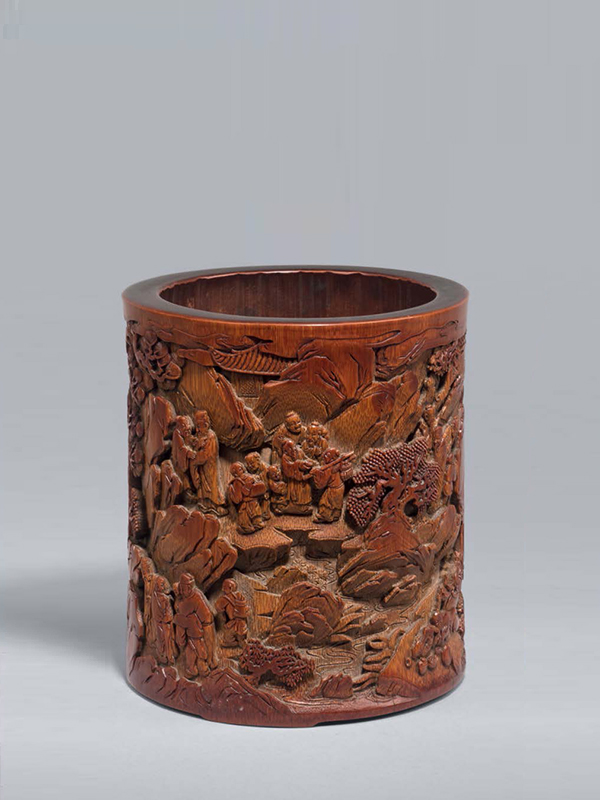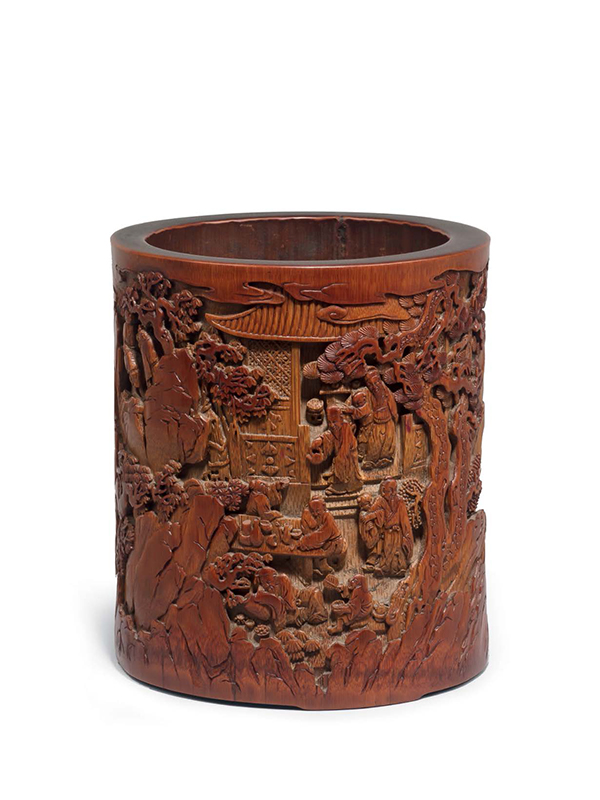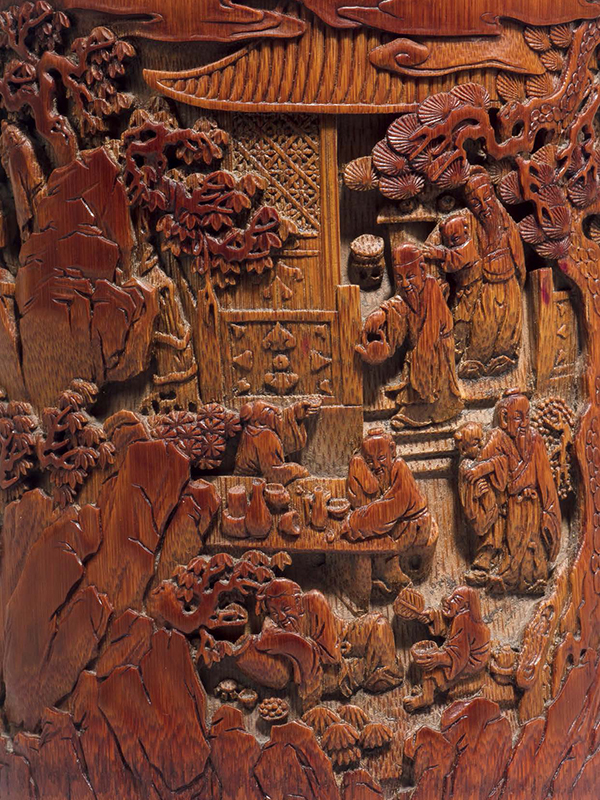Bamboo brushpot with figures in landscape
A large bamboo brushpot of cylindrical, slightly waisted shape, supported on three shallow feet. The exterior is carved in high relief combined with shallow carving, depicting in great detail a scene of scholars in a landscape setting with rocks and trees. The scene is partly set before a roofed pavilion, where it features an elaborately robed scholar sitting at a table laden with an assortment of pots and cups. A sage is holding a teapot on the steps of the pavilion, offering tea to another literati sitting beside the table, seemingly helping him to sober up. The scene is occupied by drunken literati: two are carried respectively by an attendant, with one coming out of the pavilion and the other in the yard; one is totally drunk and resting on a wine jar in the foreground; a further one is leaving the feast and is pushed forward by his attendants. On the opposite side of the brushpot various groups of figures are depicted that have just left the feast through the meandering pavement aside the mountains and are having conversations. One attendant has his arms opened, seemingly waiting to receive the drunken literati from the other side of the mountain. The upper section depicts several literati surrounded by their attendants, some sober but some still requesting more wine from the other one who carries a basket over his shoulder. The lower right section underneath the pavement depicts a servant resting on a large wine jar, whilst near him are two literati, recumbent on a rocky ledge, surrounded by partly spilt crockery. A third scene has a literati, obviously the worse for wear, carried by two servants in the foreground. The two sides are separated by large groups of pine trees and rocky mountains. The brushpot has its original bamboo joint as its base, whilst the interior is smoothly polished with well-aged patina.
This exquisite bamboo brushpot is in superb condition and represents the peak of bamboo carving technique of the early Qing period. The art of bamboo carving emerged and established itself in Wuzhong (Suzhou in Jiangsu province) and its vicinities during the mid-Ming dynasty. Jinling (Nanjing) and Jiading, both in Jiangsu province, became the two key regions of bamboo carving activity. Around the late-Ming and early Qing dynasty, Jiading bamboo carvers started to combine high and low reliefs to give variety and contrast. The levels of different depths in protrusion increased from initially only a simple one or two to ‘deep and shallow altogether five or six different grades’ by the time of Kangxi’s early reign.[1] The subject depicted on this brushpot, a group of scholars having a leisurely time in the mountains, possibly represents the famous reunion known as ‘the nine worthies of the Tang (Xian shan jiu lao)’—a group of nine poets over the age of seventy who met at the Fragrant

Fig. 1 Brush pot by Gu Jue, Metropolitan Museum of Art
Mountain Temple near Longmen, outside the city of Luoyang, in the Tang dynasty during the late 9th century. These nine poets were known to be disaffected from the politics of the day and sought solace in poetry, wine and conversation. The most famous among these nine poets is Bai Juyi (772 – 846), who spent his last years at the temple. He was known also by his literary name, ‘Hermit of Fragrant Mountain’. The subject is commemorated in numerous paintings throughout the time. Two closely comparable bamboo brushpots with a decoration of figures in landscape, both dated to the Kangxi period and similar in the carving techniques, are in the collection of the Metropolitan Museum of Art. One of them is carved by a famous Jiading bamboo carving artist Gu Jue (act. late 17th century), whose works are known for their highly complex compositions and meticulously executed details (fig. 1).[2]
Another brushpot carved with a garden scene in high relief, similarly with its original bamboo joint and dated earlier to the late Ming to early Qing dynasty of the 17th century, is also in the collection of the Metropolitan Museum of Art.[3] Some further comparable bamboo or wood brushpots, similarly carved with literati in landscape setting in high relief, are in the collection of the Palace Museum, Beijing.[4]
- The National Palace Museum, Taipei, exhibition of Uncanny Ingenuity and Celestial Feats – The Carvings of Ming and Qing Dynasties, online https://www.npm. gov.tw/exh98/carvings/en_02.html
- Leidy. D. P., Siu, Wai-fong A. and Watt, J. C. Y., Chinese Decorative Arts, The Metropolitan Museum of Art Bulletin, v. 55, no. 1, Summer 1997, p. 50. The other one is in the Metropolitan Museum of Art online collection archive, accession number 2011.7
- Ibid. p. 48
- Zhongguo mei shu quan ji bian ji wei wuan hui, Zhongguo Mei Shu Quan Ji- Gong Yi Mei Shu Bian-Zhu mu ya jiao qi, Shanghai, Shanghai ren min mei shu chu ban she, 1985, nos. 13, 34, pp. 12, 32
竹雕香山九老圖筆筒
清 康熙 1662 – 1722 高:15.5 公分 寬:14 公分
竹雕圓柱形筆筒,從天然竹節處截開成底,兩面以山石及勁松為界,刻劃出香山九老歡聚暢飲之
後的餘韻。一面樹影掩映屋舍,屋內可見一老者醉後由侍童攙扶方能站立,前方一耆老手提茶
壺,為桌前一人倒茶醒酒 ; 桌上杯盤狼藉、一老者撐頭打盹,最前方另外一位老者不勝酒力,半
臥寐於酒罈之上。左上角山石後方,一小群人似剛離開宴席,一位老者需由侍童推動方能前行。
另外一面右方有羊腸小徑,一小童雙手上伸,似在迎接穿行之人。中央山泉分隔畫面成上下兩部
分,上方老者似未能盡興,仍手持酒杯索飲 ; 右下方兩人已醉臥於地,一旁小童扶缸掩嘴而笑 ;
左下方一位老人則醉到不能行走,需由兩位侍童攙扶離境。
竹刻藝術於明晚期主要興盛於江蘇的金陵地區與嘉定地區。明晚期至清初,嘉定竹人運用高浮雕
搭配淺浮雕技法雕製竹刻品,紋飾的層次從一、二層開始發展,日漸深邃,至清康熙前期已是「
窪隆淺深可五六層」。清代前期,嘉定竹刻則呈獨領風騷之姿。本品描繪「香山九老」圖,典故
源自唐朝詩人白居易(自號“香山居士” ) 在故居與八位耆老聚會宴飲,既醉且歡。後人思慕這
段風雅韻事,因而產生許多描繪老賢者們宴集的作品。美國大都會博物館藏有兩件清康熙年代竹
雕筆筒,其一為嘉定竹雕大家顧玨所刻,刻工深淺層次出神入化,可為比較。



